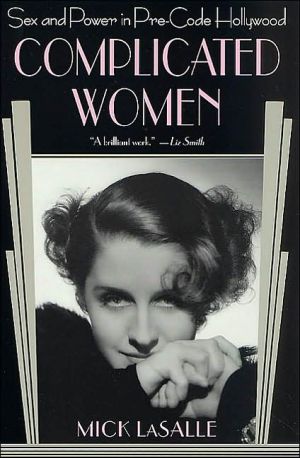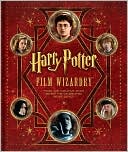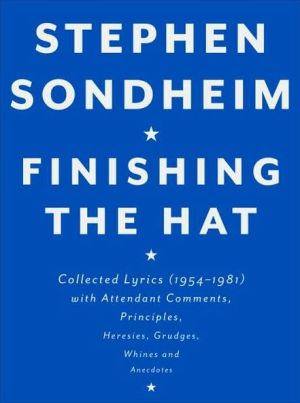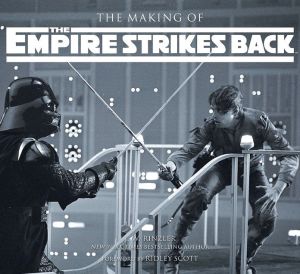Complicated Women: Sex and Power in Pre-Code Hollywood
In the pre-Code Hollywood era, between 1929 and 1934, women in American cinema took lovers, had babies out of wedlock, got rid of cheating husbands, enjoyed their sexuality, led unapologetic careers, and, in general, acted the way many think women only acted after 1968.\ Before then, women on screen had come in two varieties-sweet ingenue or vamp. Then two stars came along: Greta Garbo, who turned the femme fatale into a woman whose capacity for love and sacrifice made all other human...
Search in google:
In the pre-Code Hollywood era, between 1929 and 1934, women in American cinema took lovers, had babies out of wedlock, got rid of cheating husbands, enjoyed their sexuality, led unapologetic careers, and, in general, acted the way many think women only acted after 1968. Before then, women on screen had come in two varieties-sweet ingenue or vamp. Then two stars came along: Greta Garbo, who turned the femme fatale into a woman whose capacity for love and sacrifice made all other human emotions seem pale; and Norma Shearer, who succeeded in taking the ingenue to a place she'd never been: the bedroom. In their wake came a deluge of other complicated women-Marlene Dietrich, Jean Harlow, and Mae West, to name a few. Then, in July 1934, the draconian Production Code became the law in Hollywood and these modern women of the screen were banished, not to be seen again until the code was repealed three decades later. A thorough survey and a tribute to these films, Complicated Women reveals how this was the true Golden Age of women's films. BUST Magazine LaSalle captures the creative flair and liberal sexuality that dominated a magical five year period in Hollywood with such venerating detail that one can enjoy it all, cover to cover, in a single sitting.
\ \ \ \ Introduction\ The best era for women on screen was not the forties, as has been commonly assumed. The best era had nothing to do with ladies with big shoulder pads and bad hairdos watching their boyfriends light two cigarettes at the same time. It had nothing to do with women apologizing for their strength in the last ten minutes of every film. It had nothing to do with weeping and constant sacrifice and misery.\ Those movies may be enjoyable. We may like those movies. But they don't represent the best in women's pictures.\ The best era for women's pictures was the pre-Code era, the five years between the point that talkies became widely accepted in 1929 through July 1934, when the dread and draconian Production Code became the law of Hollywoodland. Before the Code, women on screen took lovers, had babies out of wedlock, got rid of cheating husbands, enjoyed their sexuality, held down professional positions without apologizing for their self-sufficiency, and in general acted the way many of us think women only acted after 1968.\ They had fun. That's why the Code came in. Yes, to a large degree, the Code came in to prevent women from having fun. It was designed to put the genie back in the bottle—and the wife back in the kitchen. We'll discuss this wretched Code later, and at length. But suffice it to say, to a surprising extent, it succeeded.\ Another assumption that needs disposing of is the notion that directors are more important than actors. That may be true enough sometimes, but if we're talking about pre-1940 American film, the opposite is more often the case. Indeed, it's pretty pointless to discuss pre-1940American film as the art of the director when, in most instances, the stars and the producers called the shots.\ Personality was something revered and worshipped in twenties and thirties cinema. People and faces were things to be marveled at. For the first time in history, human beings had the privilege of sitting in the dark and looking at the faces of other human beings, often beautiful ones, thirty feet high and lit up with emotion. Audiences became addicted. They wanted nothing but to bask in and contemplate the faces and personalities they encountered on the screen.\ Keep in mind, the close-up was something new back then, newer than the movies themselves. The close-up had only come into widespread use in the second half of the 1910s. Before that, people not only never got to see a close-up in films—they never saw one in real life. Real life does not allow people to look at strangers so coldly, worshipfully, appraisingly—and safely. Is it any wonder then that audiences, in the first flush of this amazing new-found privilege, became entranced and fell in love—or that studios catered to that love? Or that it took a full generation for the huge, loving, glistening, soft-focus close-up to seem corny and to fade from view?\ In a cinema that worshipped faces and personalities, the stars were, simply enough, people whose faces and personalities were deemed worthy of such contemplation. Their movies answered the need their essences inspired. Their movies were like the rock videos of today. They existed to put the star over, to capitalize on the image, and sometimes to advance the image. The stories were like little myths created around a screen personality, there to provide the audiences with the opportunity to look at and think about the star.\ Image—the public's idea of a personality—was everything. Studios packaged images, sometimes clumsily, sometimes obviously, sometimes slickly, sometimes with great sophistication. And occasionally, when forced to follow a performer's lead, they helped to create something powerful and socially important.\ Greta Garbo and Norma Shearer were stars of the first order who emerged during the image-conscious era of the mid-twenties. Their movies are still worth watching. When we trace their evolution, from film to film, we do more than get entertained or see strong personalities flowering. We encounter a kind of story working underneath the stories. These actresses used the raw materials of their faces, personalities, and concerns to leave a body of work that reveals a lot about the journey of women in the transitional decade of the 1920s. To watch them is to see the culture move toward a modern sensibility and to see women come into their own.\ \ \ WHEN GARBO AND SHEARER started their careers, there were only two kinds of women in the movies. Actresses' images were confined to one-dimensional roles straight out of the nineteenth century. A woman of sexual power was evil, if she chose to exercise and enjoy her power. And a nice woman stayed virtuous, even if she did, like Clara Bow, put on a short skirt and go dancing every night. Those were the choices, vamp or ingenue. Take one or the other. Everything else was just a variation on a theme.\ Garbo, by nature aloof and mysterious, was forced to play the vamp, a role she hated. Shearer, who radiated integrity, was forced to play the innocent ingenue, which frustrated her. So they rebelled. Overtime, and with some struggle, they persuaded Hollywood to drop the stereotypes and greet the new day. They made the movies safe for real women, and a flood of actresses followed them.\ It didn't happen all at once, but they were able to succeed thanks to certain shared advantages. First of all, they had clout. Each had the power that goes with popularity, and each had that power by the time she was twenty-two. Secondly, they worked at MGM, the studio that cared most about cultivating stars over the long haul. Thirdly, they came along at a time when censorship was relaxed. And finally, their careers happened during a period in history when audiences could not get enough of movies about women.\ That last point is all important. Since 1960, female stars have been second-class citizens, but in the twenties and early thirties, women dominated at the box office. The biggest stars were women, and it was a rare month indeed when a male face turned up on the cover of a fan magazine.\ Off screen and on, nothing was more interesting than women's stories: Women got the vote and were increasingly attending college and pursuing careers. Ten times more women were enrolled in public colleges in 1920 than in 1900. Hemlines were raised from the ankles, where they had hovered for centuries, to just below the knees. Women got to throwaway their corsets. In place of corsets, women wore brassieres (a new invention), bound their breasts for a boyish look, or, like Garbo, Shearer, Madge Evans, Jean Harlow, and many others, went braless.\ Bobbed hair was part of the new freedom. Though later generations would associate freedom with long hair, to women in the twenties long hair just meant having to tend it, comb it, and tie it up in a severe bun. Short hair was loose and liberating. Young women started wearing makeup, too—and flaunting it, powdering up and applying lipstick in public. To the older generation, this was scandalous. Makeup was regarded as immoral, something associated with bohemians and prostitutes. So was smoking. Bryn Mawr caused a controversy when it lifted its smoking ban in 1925, at a time when a woman's smoking was still reason for expulsion at many colleges. But by the end of the decade, most colleges had gone the way of Bryn Mawr. Meanwhile, the availability of diaphragms, spermicidal jellies, and pessaries in the twenties resulted in real changes in sexual behavior.\ Today, repertory-house audiences get a kick out of the similarities between today and yesterday when they see Norma Shearer going on a self-described ``orgy'' through Europe in Strangers May Kiss. What the modern audience is less likely to appreciate is that in 1931, this sort of story was both shocking and extremely new. Not only could this tale not have been told ten or fifteen years earlier, but before the widespread availability of birth control, this story couldn't have happened.\ Movies of the silent era both reflected society's changes and fueled them. Yet for all this turbulence and excitement, the sexual double standard held on. Lillian Gish and Mary Pickford played virgins—and so did Clara Bow and Gloria Swanson, though they were more fashionably dressed. In 1929, Aldous Huxley wrote of the new generation of women, ``They have the right, if not to be less virtuous than their grandmothers were, at any look less virtuous.'' Looking and seeming were as far as movies dared to go for a time.\ Yet fast-forward three years to 1932: ``Norma Shearer has killed our grandmothers,'' wrote Motion Picture Magazine:\ She has killed what they stood for. She has murdered the old- time Good Woman. She has cremated the myth that men will never marry ``that kind of woman.'' She has abolished ``that kind of woman.'' There remain—free souls.\ How Shearer did it was by taking the ingenue into the bedroom and making everybody like it. She transformed herself from a nice young thing into the exemplar of sophisticated modern womanhood and became the first American film actress to make it chic and acceptable to be single and not a virgin on screen.\ Garbo went in the other direction. She took the evil vamp and turned her into a martyr, a woman whose capacity for love and sacrifice made every other human emotion or endeavor seem small. The vamp had been a stereotype based on male paranoia and misogyny, but Garbo turned it on its head and used it to give voltage to a romantic vision that was deeper and stronger than anything anyone had ever seen.\ \ \ IN THE DECADES SINCE their retirement in the early forties, Garbo and Shearer have gone on to different critical destinies. Garbo, often lauded as one of the greatest screen actresses, has been the subject of scores of books and documentaries, while Shearer has been largely ignored, misrepresented, or misunderstood. If there were any justice, Shearer would be universally heralded as a feminist icon. Unfortunately, she made two mistakes that damaged her place in posterity: Romeo and Juliet and The Women.\ In the former, at age thirty-three, Shearer flitted about preciously as Shakespeare's fourteen-year-old-heroine. It was embarrassing. Conversely, The Women was a good picture by any stretch, and Shearer was quite respectable in it, but the role she played, the noble wife, was just this side of sainthood. The combination of those two films, which are the most frequently revived, has fixed an impression of Shearer as some kind of gracious, smiling Pollyanna.\ In fact, Shearer was a gracious, smiling subversive. Her most characteristic films, such as The Divorcee and Riptide, told audiences that the loving wife and the proper society gal was, sexually, a loose cannon. Her movies explored women's feelings about love and sex with an honesty that would be considered frank by modern standards. Garbo was not about confrontation. Garbo movies such as Mata Hari, As You Desire Me, and Camille were all about redemption through conformity. But the two actresses shared one odd, distinctive trait: Their films were invariably about the morality of the women they played. It was as if every plot were just a pretext for the real questions, ``Who is this woman? Is she good or is she bad?''\ Always, the answer was that they were good. But they stretched the boundaries of ``good'' with every move they made. Like many of the best stars, Garbo and Shearer came along in an era of cultural transition and showed audiences brand new ways to be good people.\ Before long, a torrent of other actresses burst upon the culture, making risqué films, usually about fallen women. Garbo and Shearer may not have been responsible for their appearance, but to a large degree they paved the way and set the tone, and they remained the advance guard. Garbo's Queen Christina, in which she played a bisexual, is the most daring and humane examination of sex and gender the studio system ever produced. And Shearer kept pushing the limits. The near-transparent gown she wore in A Free Soul, which still incites gasps at repertory houses, inspired a 1931 letter to Photoplay calling her (with Harlow) one of ``the least- dressed women'' in movies.\ To see their films and those of other pre-Code women is to wonder where the American cinema might have gone had censorship not forced Hollywood to change course. Never again, at least not for the rest of the century, would Hollywood ever see such an eruption of female talent: Tallulah Bankhead, Constance Bennett, Joan Blondell, Ruth Chatterton, Mae Clarke, Claudette Colbert, Joan Crawford, Bette Davis, Marlene Dietrich, Ann Dvorak, Glenda Farrell, Kay Francis, Ann Harding, Jean Harlow, Katharine Hepburn, Miriam Hopkins, Carole Lombard, Myrna Loy, Dorothy Mackaill, Ginger Rogers, Barbara Stanwyck, Margaret Sullavan, Mae West, and Loretta Young came into their own during the pre-Code era.\ Many of them made great movies. Most of them made good movies, and all of them played women we'd recognize today as ``modern.'' The bubbleheads, the cry babies, and the evil sirens, who populated the screen after 1934 (and which many of these actresses were forced to play), were the result of a Code that did not approve of assertive, free, happy women.\ But we approve of them, and it's time we reclaim them and the pictures they left us. This book is written to help us do that.
Introduction11The Ingenue Gets a Life112Like a Virgin323I Said, "Yes"544Not Too Young and Not Too Nice755"I'm in an Orgy, Wallowing"976Shopgirls and Sex Vultures1187Getting Away with Murder1428The Ghastly Job of Living Together1659The Censors Strike Back18910The Great Garbo and Norma Who?21411Garbo's Granddaughters23012Norma in the New Millennium241Epilogue253AppendixComplicated Women on Television and Video257Acknowledgments269Bibliography273Index281
\ From Barnes & NobleOur Review\ Liberated Leading Ladies\ "No picture shall be produced that shall lower the moral standards of those who see it," reads the Motion Picture Production Code of 1930, a policy that would ultimately signal the death of screen depictions of strong, independent, complicated women until the late 1960s. But the period of cinema history preceding this era of censorship -- a period that extended from the invention of talkies in 1929 to the enforcement of the Code in 1934 -- saw an explosion of films that dealt with moral ambiguities and sexually liberated women in an even-handed and frank way that has yet to be replicated. In Complicated Women, Mick LaSalle paints an enthusiastic and lively account of the women of pre-code Hollywood who served as vanguards of the modern women's liberation movement, paying special attention to screen icons Norma Shearer and Greta Garbo and the films they made. \ People who think modern movies such as "The Piano" and "Basic Instinct" are risqué in their depiction of women as sexual beings have not seen the movies Hollywood produced between 1929 and 1934. Films of actresses such as Shearer and Garbo, Joan Crawford, Jean Harlow, and Marlene Dietrich contained scenarios and representations of women with voracious sexual appetites and so-called loose morals that would shock some of today's moviegoers. These women were unapologetic adulterers, prostitutes, and participants in orgies. They left their husbands and seduced men simply because they could. And audiences loved them.\ But, as LaSalle posits in Complicated Women, the underlying message of these films, the reason why their value transcends their entertainment worth, was that morality could be relative, sexuality could be independent of love, and women could be as unsentimental as men and maintain an aura of integrity that had nothing to do with their sexual exploits.\ These were certainly radical notions, born of the postwar social climate and the newly widespread availability of contraception, and LaSalle devotes some attention to this aspect. But he gives much of the credit for the progressive content of pre-Code movies to the actresses who starred in them and made audiences love them. There can be no doubt LaSalle is an avid and knowledgeable film buff and his spirited descriptions of the era's stars and their films make for a quick, enjoyable, and juicy read.\ It is with some dread one reads on, knowing the Code's enforcement and the end of America's feistiest film era -- and with it, this extremely readable book -- are right around the corner. LaSalle's digression into contemporary movies and female stars is a little tiresome; he seems at times to be showing off his sizable knowledge of the movies, rattling off the names of virtually every actress to have appeared in a movie in the last 10 years. But otherwise, Complicated Women is a rousing account of a vibrant moment in movie history.\ --Karen Burns\ \ \ \ \ \ From the Publisher"LaSalle's marvelous Complicated Women is the best kind of film book, making us see with fresh eyes the women of pre-Code Hollywood, a truly revolutionary lot by any standards. LaSalle wittily and insightfully celebrates the multiform 'New Woman' of the late '20s and early '30s. The author does a persuasive job of reminding us of the contribution of lesser-known stars while rescuing the much-maligned Norma Shearer from her gilded cage as MGM's plastic princess and restoring her to her rightful place as a breathtakingly risky (and risqué) sensualist with plenty of career savvy. Bravo!"—Molly Haskell, author of From Reverence to Rape: The Treatment of Women in the Movies\ "Mick LaSalle's Complicated Women isn't just a great title for life, it's an eye-opening examination of pre-Code Hollywood that retrieves lost films and overlooked careers. It's also a delight to read and argue with."—David Thompson, author of Beneath Mulholland and Rosebud\ "Mick LaSalle is a guy who really knows his stuff. He's actually seen everything he writes about, evoking a whole era of forgotten movies in a refreshing style that's not just a series of rehashed plots, but a witty, insightful joyride without an ounce of pomposity or patronizing, while at the same time providing the unsuspecting viewer with a fun guide on how to 'read' pre-Code movies."—Bruce Goldstein, Director of Repertory Programming, Film Forum, New York\ "Mick LaSalle's Complicated Women is a revelation: He takes us back, with wit, passion, and intelligence, to those brief shining years of the early 1930s when Hollywood women movie stars like Norma Shearer could be erotic, funny, and independent—with no hell to pay."—Kate Buford, author of Burt Lancaster: An American Life\ "Sophisticated and provocative."—Entertainment Weekly\ "An overdue examination of a historic conflict between Hollywood and would-be monitors of morality."—New York Times Book Review\ "In prose as snappy and sassy as the movies he describes, LaSalle restores to their rightful stature smart, sexy actresses like Ann Dvorak . . . and especially Norma Shearer."—Elle\ \ \ \ BUST MagazineLaSalle captures the creative flair and liberal sexuality that dominated a magical five year period in Hollywood with such venerating detail that one can enjoy it all, cover to cover, in a single sitting.\ \ \ \ \ Liz SmithThis book chronicles the careers of a number of vintage stars but concentrates on Norma Shearer, who, like Mary Pickford, is somewhat forgotten and misrepresented today. A brilliant work, and a revisionist view of a great and glorious MGM lady ... who really wasn't such a lady.\ \ \ \ \ Publishers WeeklyMovie quiz: who said, "I'm in an orgy, wallowing. And I love it!" Madonna? Demi Moore? Koo Stark? No, it was Norma Shearer in 1931's Strangers May Kiss. In this breezily written, engaging look at the position of women in pre-Code Hollywood pictures, LaSalle uncovers a host of actors (some, like Ann Dvorak and Glenda Farrell, now almost forgotten) and films that broke social barriers with their frank portrayals of female sexual desire and freedom. Contradicting prevailing film theory that claims the 1940s as the golden age of women in film, LaSalle boldly posits that the best women's movies were made before 1934, when the studios were forced to follow the notorious Production Code. According to the author, pre-Code Hollywood films reveled in nonjudgmental, often quite serious, portraits of women characters exercising enormous sexual, personal and social freedoms--from sex outside marriage to having their own careers. "The Production Code," LaSalle notes, "ensured a miserable fate... for any woman who stepped out of line." Drawing upon movies, reviews, social trends such as rising female college admissions and even the writings of feminists such as Charlotte Perkins Gilman, he makes a solid case that the freedom women gained in the 1920s changed America, and that this change was reflected, and reinforced, in films. Along the way, LaSalle offers a variety of revealing insights--such as his observations on the anti-Semitism of Roman Catholic clergy in their war against Hollywood--as he entertainingly traces the careers and early work of such major stars as Barbara Stanwyck, Joan Crawford and the once-famous Ruth Chatterton. Photos not see by PW. (Sept.) Copyright 2000 Cahners Business Information.\|\ \ \ \ \ Library JournalBetween 1929 and 1934, Hollywood was governed by a voluntary code of decency. During this period, women characters were often tough-talking, sexually aggressive, and independent. Under pressure from church and state decency groups, a code with enforcement powers was implemented in 1934. The effect of the 1934 code (which remained in effect until the late 1960s) has been hotly debated recently. LaSalle, film critic for the San Francisco Chronicle, makes it clear what he thinks, blasting the code as a measure "to prevent women from having fun. It was designed to put the genie back in the bottle--and the wife back in the kitchen." He calls the code, as enforced by Joseph Breen, "anti-art," antiwoman, and anti-Semitic. However, LaSalle's main purpose is to celebrate the short-lived era of "complicated women," as personified by the early films of Marlene Dietrich, Jean Harlow, Myrna Loy, and others. In particular, this book is an unabashed valentine to Greta Garbo and Norma Shearer. It features insights on significant scenes from precode films and evaluates some modern counterparts to the great ladies of the early 1930s. This book is more narrowly focused than other recent books on the subject--such as Thomas Doherty's Pre-Code Hollywood (LJ 7/99) and Mark A. Viera's Sin in Soft Focus (LJ 11/1/99)--and some may disagree with the author's conclusions, but it is recommended for large film and women's studies collections.--Stephen Rees, Levittown Regional Lib., PA Copyright 2000 Cahners Business Information.\\\ \ \ \ \ WebsterLa Salle, the film critic for The San Francisco Chronicle, has an avuncular but informative style, and makes his points with a relaxed economy. After decades of neglect (many pre-code films were rarely shown on television because of their provocative content), such movies have gained a new following at film festivals. Complicated Women, an overdue examination of a historic conflict between Hollywood and would-be monitors of morality, should only enhance their resurrection. \ —New York Times Book Review\ \ \ \ \ ElleIn prose as snappy ans sassy as the movies he describes, laSalle restores to their rightful stature smart, sexy actresses like Ann Dvorak, Glenda Farrell, and especially Norma Shearer...\ \ \ \ \ Entertainment WeeklyLaSalle writes wittily about the risque world Hollywood created in the Pre-Hays-code 1920s and 1930s...The examination of women's roles in pre-Code and present-day films is sophisticated and provocative\ \ \ \ \ Kirkus ReviewsAn overdue tribute to the myriad of strong and independent women film stars of pre-Code Hollywood (1929-34).\ \








